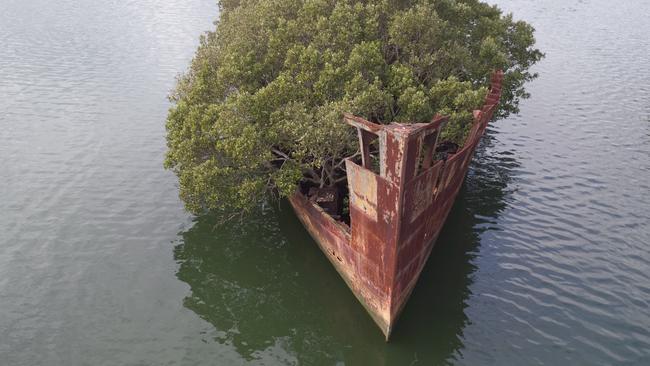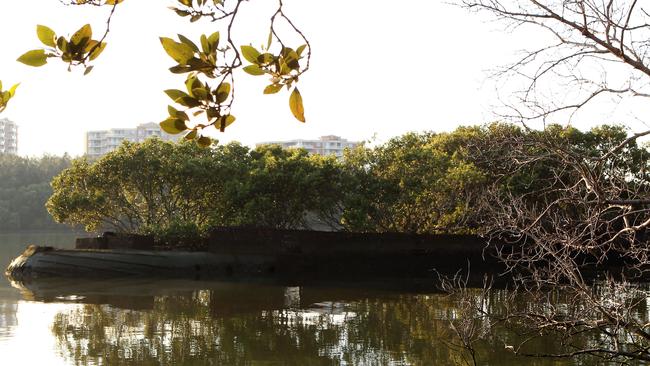The bizarre hidden shipwrecks of Sydney Harbour where nature has taken over
A DECADE after the Pasha Bulker ran aground, even more bizarre rusting hulks lie forgotten in a hidden corner of Sydney Harbour.
TEN years ago this month, the container ship Pasha Bulker ran aground on Newcastle’s Nobbys Beach instantly becoming a tourist landmark.
For a few weeks in winter 2007, the addition of a stranded 77,000 tonne hulk saw Newcastle rival the landmarks of Sydney Harbour.
But just a few kilometres west of the Opera House, in a quiet corner of the harbour, lie a group of ships that could rival the Pasha Bulker in terms of their sheer spectacle. Yet few Sydneysiders know about these strange sights, silently resting in plain sight.
These rusting wrecks, lying in the shallows, have seen their innards completely colonised by trees. Where railings and ropes once ruled, now branches and bark have taken root shooting skywards creating a giant green dome over the slowly disappearing shell.
While most wrecks are hidden deep under the ocean, the remains of the SS Ayrfield — and its neighbours — are completely visible from land and the hundreds of homes just metres away.

Described as eerie by some, this meeting of man and nature is fast becoming a mini tourist attraction.
The wreck of the SS Ayrfield is one of at least seven dotted close to the heavily wooded banks of Homebush Bay. In some photos the strange ships can seem far from civilisation, but they actually lie within earshot of the roars from Sydney’s Olympic stadium. A huge Ikea is just across the water.
This bay has become a graveyard of once illustrious vessels which, like the Marie Celeste, are now abandoned at sea.
“It’s something forged in heat and sparks that nature has taken back over. Something man-made and something natural coexisting together,” Maritime Archaeologist Stirling Smith from the NSW Office of Environment and Heritage tells news.com.au.
“The wrecks are a visually spectacular hidden treasure. We were lucky when the Olympics were built because they protected all this area and redeveloped it but without impacting on the natural heritage or the shipwrecks.”


The corroding hulks have become a favourite for photographers. Scott Stramyk is part of the Canon Collective and has held photography workshops focused on the wrecks of Homebush Bay and, in particular, the Ayrfield.
“There are some angles that make it look like there’s nothing around,” Mr Stramyk says.
“We posted a sunset image of the Ayrfield online and people thought it must be in some remote part of tropical Queensland, yet it’s just in the back end of Sydney by some apartments.”
At certain times of day the soundless wrecks take on an altogether different atmosphere, like a flotilla of ghost ships approaching the shore.
“It can be really eerie, especially at night if you have the fog floating over the mangroves,” she tells news.com.au.
The Ayrfield’s journey began in 1911 in a dockyard in Grangemouth, Scotland. Arriving in Sydney a year later, it was originally called the Corrimal and during the Second World War it would transport supplies to US troops in the Pacific.

When the war ended it was renamed and became a collier on the “sixty miler” run transporting coal from Newcastle to Sydney.
“It came to Homebush Bay in 1972. Back then this was an industrial area, and a bit of a backwater not on the main channel of the Parramatta River, so it was a nice quiet place which no one called home to strip the vessels,” says Mr Smith.
“There were slipways they could bring vessels up to, strip them of their parts and then take them away to be scrapped or melted down.
“Some ships were reduced to absolutely nothing, some to just the keel in and many are resting underwater.”

That would have been the fate for the Ayrfield and the other wrecks, including the SS Heroic, HMAS Karangi and a collection of barges. But fate intervened.
“In 1972, the scrap metal prices were staring to decline so they started closing down the companies,” he says.
The remaining vessels were left to rot where they were in a part of the harbour no one, certainly not a tourist, cared about.
Many of the ships lie just a few metres from mangroves that crept over to the vessels.
“They’re very sheltered here, they’re not being battered by surf, so it’s a nice spot for the mangroves to grow. There’s mud inside the hull and they’ve taken advantage of it and they are absolutely thriving,” says Mr Smith.

New residential developments now fringe the shore overlooking the Ayrfield which has helped more people to learn of the existence of the wrecks. A few years ago a Japanese TV crew filmed a segment of a game show with the ship as a backdrop. They nicknamed the ship the “afro”, says Mr Smith, due to its distinctive foliage.
However, his favourite wreck is the HMAS Karingi, a little further down the bay.
It too has trees growing through it, but in a different style. “I wouldn’t call that one an afro, maybe a buzz cut because it’s a bit shorter,” he says.
“It has an amazing history. It was in Darwin Harbour during the Japanese bombing raid in WWII and the British nuclear tests at the Montebello Islands in Western Australia and then it was bought here, stripped and left.”
Other ships lie hidden in the midst of the mangroves, inches from shore, destined to sail no more.
It’s not just boats; cables, cranes and winches are also dotted around, breaking apart and sinking into the mud.

Mr Stramyk says winter was the perfect time to photograph the wrecks. The sun low in the sky and the lack of haze brings a crispness to shots. At sunset, the rust on the hulls is lit up a fiery orange against the bright green of the mangroves.
“It’s so abstract to what you normally see around Sydney. It creates a nice juxtaposition of the ruin of the ship and the trees growing through it, coming out of its guts.”
Mr Smith warns wreck fans not to wade out to the deteriorating vessels, the metal of which is sharp in places including under the water line.
But he’s pleased they are becoming better known. “They’re unique in that they are so visible to so many people.”
He doesn’t mind that they are slowly crumbling.
“Eventually they will start to collapse and when they do we’ll start seeing different parts of the ship.”
Decades into the future, the Ayrfield and its silent neighbours, will indeed finally rust away. Then, all that will remain will be the mangroves that once sheltered within these mighty seafaring skeletons.

